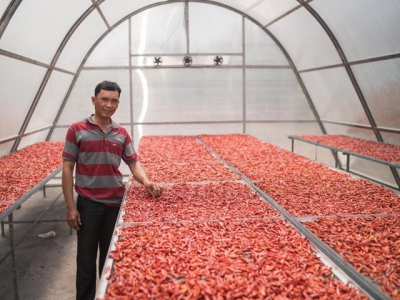Solar dryer dome technology solution enhance climate change resilience

Solar Dryer Parabola Dome is the result of 30 years of research by Dr. Serm Janjai of Silpakorn University. The dryer works with the principles of greenhouse drying for agricultural products such as bananas, tomatoes, chili, coffee, cocoa, spices and herbs, etc.
Drying chili in Dong Thap, Vietnam
Their parabolic shape allows the best use of solar radiation, and rain water runs off easily. The polycarbonate sheets used to cover the dome creating the greenhouse effects are made of high-value, high-quality Covestro polycarbonate, and are coated with a UV protection layer. Being shielded from UV, agricultural produce keeps its vibrant colors and valuable nutrient values. This results in higher valued final products.
The dryer is easy to transport, and is installed locally. It reduces significantly the risk of spoilage and hygiene concerns caused by dust, water contamination, and livestock animals.

Small size Solar Dryer Dome (6m x 8m)

Large size Solar Dryer Dome (9m x 22m)
This solution in post-harvesting processing can help tackle the post-harvest loss and enhance the resilience against climate change among farming communities in Southeast Asia.
For example, according to the Climate Change Scenarios for Vietnam 2016 – Report by Vietnam Ministry of Natural Resources and Environment, the rainfall indicator differs strongly between the climate change scenario in 2012 and in 2015. Rainfall, as forecast in 2012, would actually decrease by 2-12% but is now predicted to increase by 5-15% (from the period of 2016-2035). High rainfall increases in rainy season while in dry season, rainfall tends to decrease. Hence, drought and floods would become more complicated. Consequently, conventional drying in open air will face more challenges. Unpredictable weather encourages moving post-harvesting activities to closed space.
A sustainable inclusive business model to scale this drying solution has been established in Myanmar and Indonesia; however, still under development in Vietnam. More details on these inclusive business models will be shared in upcoming entries.
Inclusive Business Development Manager, Covestro Vietnam
Related news
 Mechanical Water Circulation Aids Pond Water Quality
Mechanical Water Circulation Aids Pond Water Quality Mechanical water circulation can prevent stratifica-tion and provide more dissolved oxygen near pond bottoms
 Water Temperature in Aquaculture
Water Temperature in Aquaculture Aquaculture ponds should not be deeper than about 2.0 m to minimize the probability of thermal stratification.
 Light Penetration in Water
Light Penetration in Water The depth of the photic zone, the layer of water receiving 1% or more of incident light, can be estimated with Secchi disk visibility.
 Characterization and Management of Effluents from Aquaculture Ponds in the Southeastern US
Characterization and Management of Effluents from Aquaculture Ponds in the Southeastern US Nearly all commercial aquaculture in the southeastern United States is conducted in earthen ponds. Good production from ponds is encouraged by using
 Fertilization of Fish Ponds
Fertilization of Fish Ponds When ponds are fertilized, nutri-ents stimulate the growth of microscopic plants in the water (phytoplankton). Phytoplankton is food for other organisms